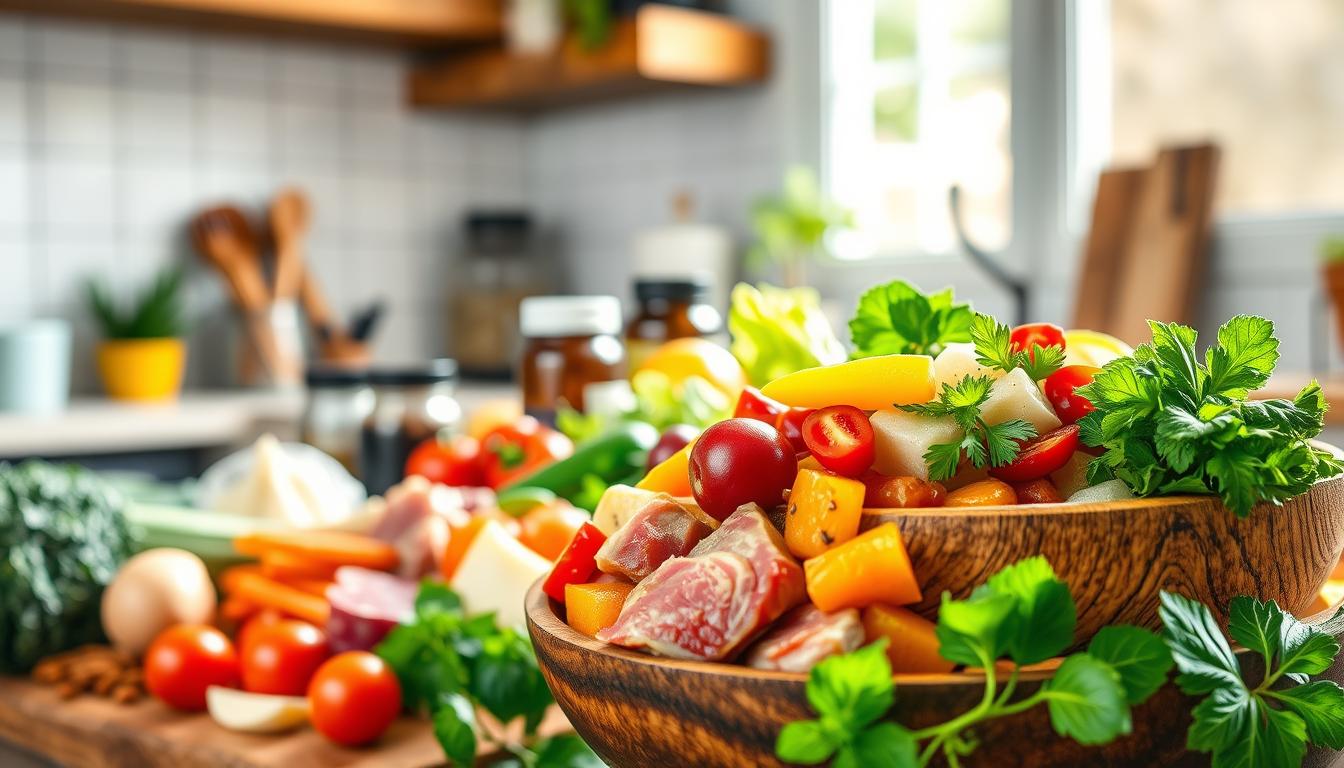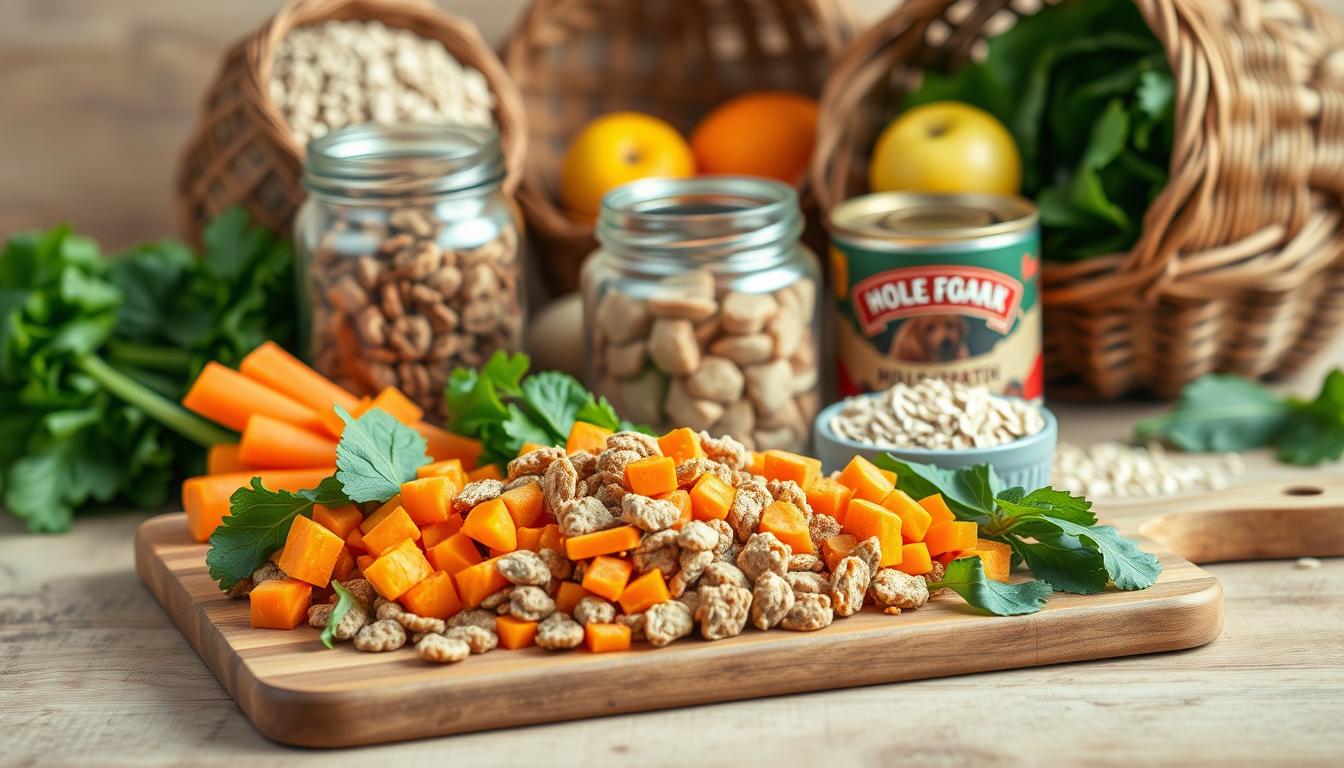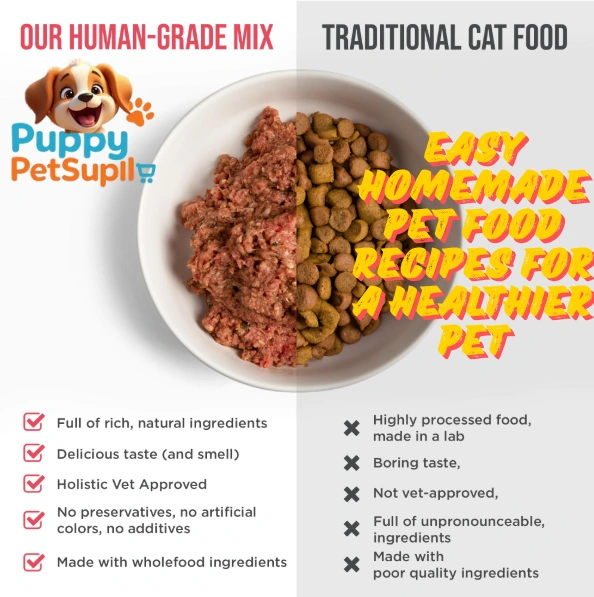Easy Homemade Pet Food Recipes for a Healthier Pet
Did you know many pets have diet-related health problems? More pet owners are choosing natural pet food to help their pets feel better. Making homemade meals can give your pet the right nutrients they need.

homemade pet food
By controlling what your pet eats, you can skip bad ingredients in store-bought food. Instead, use healthy ingredients that help your pet stay healthy. A Yorkie owner said their dog’s coat and energy got better after switching to DIY pet food.
Key Takeaways
- Preparing homemade pet food allows for tailored nutrition.
- Avoiding commercial fillers can improve your pet’s health.
- Natural pet food options promote overall well-being.
- Switching to healthy pet food can improve coat health and energy.
- Understanding pet nutrition is key to a healthier pet.
The Benefits of Switching to Natural Pet Nutrition
Switching to natural pet nutrition can greatly improve your pet’s health. Choosing homemade or DIY pet food is a big step towards a healthier life. It provides your pet with essential nutrients without harmful additives found in many commercial foods.

natural pet food benefits
Nutritional Advantages Over Commercial Options
The main benefit of homemade pet food is its better nutrition compared to many commercial foods. Commercial pet foods often have preservatives and fillers that harm your pet’s health. Homemade food, on the other hand, uses fresh, whole ingredients for better nutrition.
Pet nutrition experts say, “A diet rich in whole foods can greatly improve your pet’s health and well-being.” This natural approach to pet nutrition is becoming more popular as pet owners learn about their pet’s food ingredients.
Control Over Ingredients and Quality
Preparing your pet’s food at home lets you control the ingredients and their quality. You can avoid allergens and choose organic or local produce. This control is a big plus of DIY pet food.
Cost-Effectiveness of DIY Pet Food
Many think homemade pet food is expensive, but it can actually save money. Buying ingredients in bulk and planning meals can lower costs. Plus, the health benefits might mean fewer vet visits, saving you money on pet care.
Essential Ingredients for Homemade Pet Food
To make a balanced homemade pet food, you need to know the key ingredients. A good recipe gives your pet the nutrients they need for health. The right ingredients are key to your pet’s well-being.

homemade pet food ingredients
Protein Sources Safe for Pets
Protein is vital for your pet’s diet. Safe protein sources include chicken, beef, fish, and lamb. You can cook and serve these in many ways to keep meals exciting. It’s important to mix up the protein sources for a wide range of amino acids.
Healthy Carbohydrates and Vegetables
Carbohydrates and vegetables add fiber, vitamins, and minerals. Sweet potatoes, carrots, and green beans are great choices. They’re easy to digest and full of nutrients. Adding different vegetables to your pet’s diet helps their digestive health.
Supplements and Additives for Complete Nutrition
While whole foods are the base of your pet’s diet, supplements can fill nutritional gaps. Omega-3 fatty acids, vitamin D, and probiotics are common ones. Always talk to a vet before adding supplements to make sure they’re safe and needed.
By using these essential ingredients in your homemade pet food, you can give your pet a balanced diet. Always check with a vet to make sure the recipe fits your pet’s nutritional needs.
Homemade Dog Food Recipes
Making your dog’s food at home is rewarding. It lets you choose the ingredients and ensure they get the best nutrition. You can adjust the recipes to meet your dog’s specific needs.
Basic Balanced Chicken and Rice Recipe
This recipe is simple and nutritious. It provides a good mix of protein, carbs, and vitamins and minerals.
Ingredients List
- 1 pound boneless, skinless chicken breast or thighs
- 1 cup cooked white or brown rice
- 1 cup mixed vegetables (such as carrots, green beans, and peas)
- 1 teaspoon fish oil
- 1 egg
Step-by-Step Preparation
- Cook the chicken until it’s fully cooked.
- Mix the cooked rice with the chicken, adding the mixed vegetables and fish oil.
- Add the egg for extra protein and nutrients.
Storage and Serving Recommendations
Keep the meal in airtight containers in the fridge for up to three days. Or freeze it for later. Serve the right amount based on your dog’s size and diet.

homemade dog food recipe
Beef and Vegetable Stew for Dogs
This stew is a nutrient-rich meal for your dog. It uses beef as protein and various vegetables for fiber and vitamins.
Ingredients List
- 1 pound ground beef or beef cubes
- 1 cup mixed vegetables (such as sweet potatoes, carrots, and green beans)
- 1/4 cup finely chopped parsley
- 1 tablespoon flaxseed oil
Step-by-Step Preparation
- Cook the beef until it’s fully browned.
- Add the mixed vegetables and cook until they’re tender.
- Stir in the chopped parsley and flaxseed oil.
Storage and Serving Recommendations
Keep the stew in the fridge for up to five days or freeze it. Serve it warm, adjusting the portion size as needed.
Special Recipes for Dogs with Dietary Restrictions
Some dogs need special diets due to allergies or sensitivities. Use novel proteins like venison or salmon. Always check with your vet for the best ingredients.
Make-Ahead and Freezer-Friendly Options
Preparing dog food in advance is convenient. Make big batches of your dog’s favorite recipes. Portion them out and freeze for later. This saves time and keeps your dog’s meals healthy and consistent.
Homemade Cat Food Recipes
Making your cat’s food at home is simple and good for their health. You can pick the ingredients and ensure they’re of high quality. This way, you help keep your cat healthy and happy.
Nourishing Your Cat with Protein-Rich Chicken
A great recipe for cats is a protein-rich chicken dish. It’s easy to make and can be tailored to your cat’s tastes and needs.
Ingredients List
- 1 pound boneless, skinless chicken breast or thighs
- 1/4 cup finely chopped carrots
- 1/4 cup cooked brown rice
- 1 tablespoon fish oil
Step-by-Step Preparation
First, cook the chicken well. Then, mix it with chopped carrots and cooked brown rice. Add fish oil for omega-3 fatty acids.
Storage and Serving Recommendations
Keep the meal in airtight containers in the fridge for up to three days. Or, freeze it for longer. Serve it at room temperature.
Fish-Based Recipes for Feline Health
Fish is a great protein source for cats. A fish-based recipe can add variety and essential nutrients to your cat’s diet.
Ingredients List
- 1 pound cooked salmon or cod
- 1/4 cup sweet potatoes, cooked and mashed
- 1 tablespoon flaxseed oil
- 1 teaspoon finely chopped parsley
Step-by-Step Preparation
Mix cooked fish with mashed sweet potatoes and flaxseed oil. Add chopped parsley for freshness and nutrition.
Storage and Serving Recommendations
Store this fish-based meal like the chicken recipe. Keep it in airtight containers and refrigerate or freeze. Serve at room temperature.
Addressing Special Dietary Needs in Cats
Some cats need special diets or have allergies. When making homemade cat food, consider these needs carefully.
For cats with sensitivities, avoid common allergens like beef, dairy, or soy. Use novel protein sources like venison or duck instead.
Portion Control and Storage Tips
It’s important to control portions and store homemade cat food properly. This keeps it fresh and nutritious.
| Recipe | Serving Size | Storage Duration |
| Chicken Recipe | 1/4 cup per 10 lbs body weight | 3 days (refrigerated) |
| Fish-Based Recipe | 1/4 cup per 10 lbs body weight | 3 days (refrigerated) |
By following these guidelines and recipes, you can give your cat healthy, homemade meals. These meals will meet their nutritional needs and preferences.
Conclusion: Transitioning Your Pet to a Healthier Homemade Diet
Exploring homemade pet food shows it can greatly improve your pet’s health. A homemade diet avoids harmful additives found in commercial foods. This makes it a better choice for your pet’s health.
Switching to homemade food needs careful planning and a vet’s advice. This ensures your pet gets all the nutrients they need. It’s key to keep your pet healthy.
Choosing homemade food is a big step towards better health for your pet. It lets you tailor their diet to their needs. This not only boosts their health but also strengthens your bond with them.
Starting a homemade diet for your pet is a journey. It takes patience, dedication, and expert advice. Begin by talking to your vet to make a plan for a healthier diet.
FAQ
Feeding your pet homemade food has many benefits. It can improve their nutrition and let you control what they eat. It’s also more cost-effective. You can avoid harmful fillers and by-products found in commercial food.
To get a balanced diet, mix different protein sources, healthy carbs, and supplements. Talk to your vet to find the best ingredients and amounts for your pet.
Good protein sources include chicken, beef, fish, eggs, and turkey. For pets with sensitivities, try novel proteins like venison or duck.
Yes, you can make food for pets with special needs. For example, you can make gluten-free, grain-free, or hypoallergenic recipes.
Keep homemade food fresh by storing it in airtight containers. Use the fridge or freezer. Label containers with date and contents. Use within a few days or freeze for longer.
Yes, homemade food can have risks like nutritional imbalances. Always check with your vet to make sure your pet’s diet is balanced and healthy.
Yes, you can make healthy treats with ingredients like peanut butter, pumpkin, and sweet potatoes. Just remember to avoid toxic foods like chocolate or grapes.
Gradually introduce new foods over 7-10 days to avoid upset stomachs. Always get your vet’s advice on switching to homemade food.

